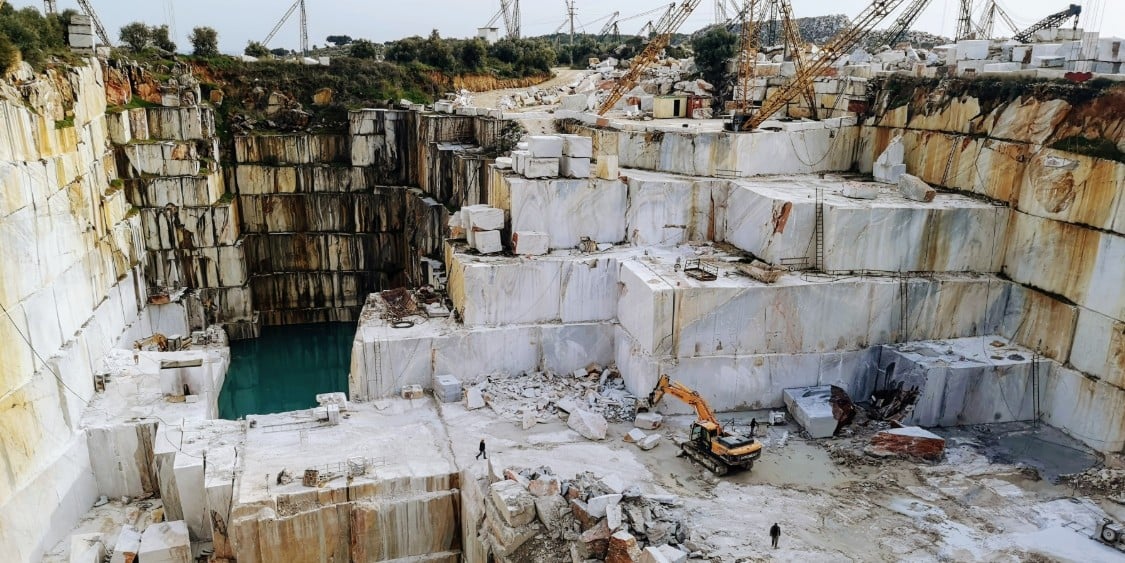Quarries are brimming with hazards. From massive vehicles to steep heights to powerful explosives, quarry workers rely on extreme measures to get the job done.
The inherent risks in quarrying cannot be completely eliminated, but they can be significantly diminished with routine risk assessments, stringent risk management programs and thorough regulatory compliance.
Use the following overview of common quarrying risks to bolster your own risk management strategies.
Excavations and Landfills
Every excavation and landfill, no matter how big or small, presents quarry workers with a whole host of risks. Poor design can lead to collapse, overhangs and vertical surfaces can send workers plummeting from heights, and inadequate accident investigations can undermine an entire project.
To counteract these risks, thoroughly investigate the site before beginning work. Assess the excavation or landfill’s risk of failure, and use your findings to ensure that your design for the excavation or landfill provides an adequate margin of safety.
You will probably need to adjust your design to align with the results from your site investigation or other information gleaned from routine working—creating a stable, solidly engineered design requires constant alteration. Simply drafting a design without testing and modifying it will not suffice.
As you implement your design and begin working, keep an eye out for the development of any cracks, collapses or anything else that could threaten structural integrity. If working on an excavation, avoid significant overhangs that could collapse without warning. Similarly, avoid producing large vertical surfaces in landfills, which represent a substantial risk of falling from height.
Stay compliant year-round by scheduling regular appraisals of the work area by a competent person to determine whether your excavation or landfill is a significant hazard. An excavation or landfill is considered a significant hazard if its failure would:
- Endanger a premises off-site where people are likely to be found; or
- Kill or seriously injure anyone.
If the excavation or landfill is found to represent a significant hazard, you should schedule a geotechnical assessment, which involves a geotechnical specialist identifying and assessing all factors affecting the structure’s stability and safety.
Vehicle Hazards
You could not do your job without your vehicles. They are a crucial component of your work responsibilities, but they are also a huge hazard. Controlling your vehicle risks starts with good drivers—make sure each one is assessed and authorized to drive for work. Require every driver to wear a seat belt and use visibility aids.
Based on the findings from your initial site investigation, erect adequate edge protection where necessary. Additionally, use your investigation findings to mark where vehicles may and may not be used. In the areas where vehicles may be used, list which manoeuvres, such as tipping or reversing, are allowed. Try to limit reversing as much as possible, and strictly control it when you cannot avoid it.
Most of your efforts to control vehicle hazards will be marking and enforcing which vehicles can be used, and when. Establish speed limits and one-way systems. Designate areas as pedestrian-only. And, to ensure your policies remain effective, your drivers should detail any accidents or near misses.
Explosives
Although your explosives supervisor will organize the safe and secure storage, handling and use of explosives, as the quarry operator you may be held responsible if anything goes awry.
You must guarantee that anyone working with explosives has been properly trained, appointed and authorized. That involves making sure explosives are stored safely and are accessible only to those authorized employees. The keys to the explosives store must be kept safe at all times, either in the custody of the explosives supervisor or shotfirer, or in a secure place.
Designate shelters for the shotfirer and any other employees present during a blast. A list of explosives rules, written by or with the help of the explosives supervisor, should address all health and safety concerns.
Danger Areas
Areas of the quarry with particular health and safety hazards and where public access is foreseeable should be marked and treated as danger areas. The entire quarry is potentially dangerous, but treating the whole thing as a danger area drains the phrase “danger area” of its seriousness—reserve it only for those exceptionally risky areas. Unauthorized people must be excluded from these areas with the use of barriers and warning signs. Danger areas include:
- Sections of the excavation which may collapse onto people, such as significant overhangs
- Edges of excavations which may collapse under the weight of people or equipment, such as water-filled excavations
- Places from which people can fall a distance liable to cause personal injury
- Places where people may be struck by falling objects, such as stones falling from conveyors
- Places with materials that behave like quicksand and could drown people
- Lagoons
Inspection and Maintenance
Because quarries harbour such an overwhelming number of quarrying risks—of which this list is only an overview—you must establish guidelines for regular inspection and maintenance. Contact the Axis Insurance Group for more information on inspection and maintenance regulations by province.


